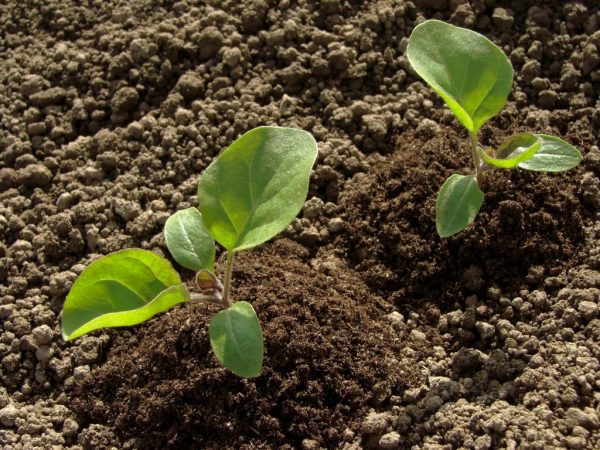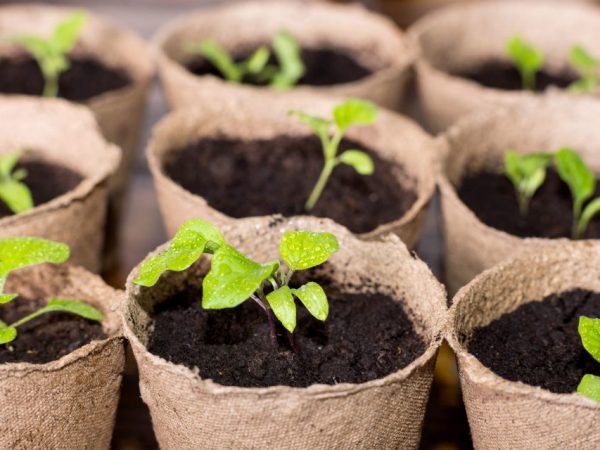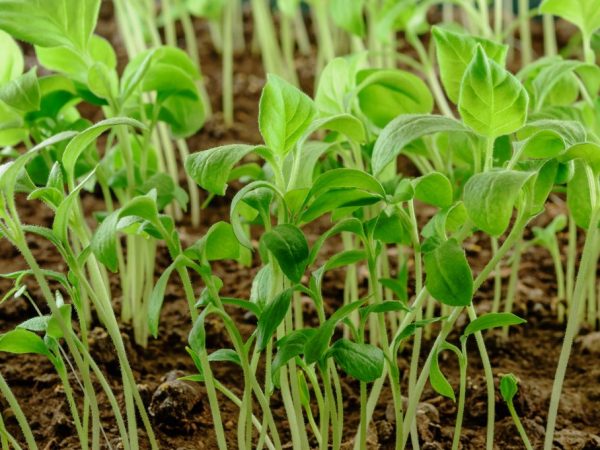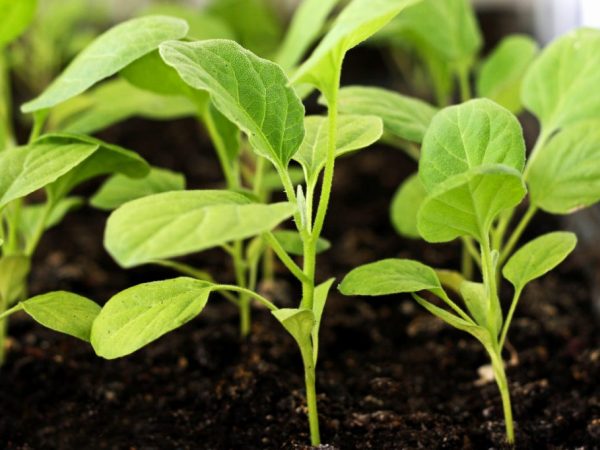Growing eggplant seedlings
Eggplants should be grown through seedlings, because they have a long growth period. High-quality eggplant seedlings require regular proper care for high yields and excellent taste.

Growing eggplant seedlings
Seed preparation
Sowing eggplants begins with preparation. For planting eggplants for seedlings, high-quality seeds are purchased. When buying, preference is given to varieties bred for specific climatic conditions.
When buying seed, be sure to check the expiration date indicated on the package. The younger the seeds, the more likely they are to germinate.
Seed treatment
Eggplants are planted for seedlings after preliminary preparation and processing. Seeds are sorted by size. Rejected damaged, deformed and moldy. Grains with atypical color, spots will not work.
Next, the seeds are checked for germination. They are placed in a container with salted water. The seeds that sprout are thrown away. The rest are dried. If all the grains float up, they may be overdried. They are trying to sow them.
Growing eggplant seedlings is not complete without disinfecting the material. The procedure helps to prevent the development of latent diseases during germination. Disinfects seeds that are not surrounded by a shell and have not undergone such processing during production.
Disinfection
Disinfection with potassium permanganate or the drug "Fitosporin M" is considered a well-known effective method. There are a number of misconceptions associated with the soaking process:
- If you add a large amount of substance, the solution will be more effective. This opinion is incorrect, since a solution with a concentration of more than 1% kills the embryo in the middle of the seed.
- Longer exposure helps better. In fact, it spoils the planting material. The optimal holding time is 15-20 minutes.
- When disinfecting the soil, disinfection is not carried out. This is also not true, as it will only help protect the seeds from the top.
Heat treatment
Disinfection is carried out using heat treatment. Seeds for 20 min. soaked in water at 45-50 ° C, and then for 1 min. - in the cold. Then leave overnight in a solution of trace elements. In the morning the next day, the planting material is placed in a refrigerator for a day, and then dried. This allows them to be free-flowing, not to rot when planting.
Stimulation
The stage of stimulation is not skipped during preparation, since the procedure accelerates the emergence of seedlings. They use special purchased products or prepare them themselves. 5 g of wood ash, sodium humate or nitrophoska is diluted in 1 liter of clean warm water. The mixture is recommended to process the grains.
Germination
Before growing eggplant seedlings in an apartment, the seeds are germinated, which increases the likelihood of sprouts taking root and accelerates their germination. A flat container is used, on which wet gauze is spread in several layers.
Eggplant seeds are evenly placed inside the material on the seedlings.The gauze is constantly moistened, kept on the heating device no more than 45 ° C. After a couple of days, eggplant seedlings germinate at home.
Sowing seeds

The root system of plants does not tolerate picking well
In the middle latitudes of Russia, planting seeds for eggplant seedlings is carried out in February-March. In more detail, the eggplant sowing time is calculated based on the developmental characteristics of each variety.
Take into account the compatibility of the variety with the region. Early, mid-season varieties in the middle lane ripen in 110-120 days. Late vegetables, compatible with the southern region, have a ripening period of 130-190 days, and their harvesting period is July-August. It is recommended to plant eggplants for seedlings in March.
Eggplant seedlings are grown with or without a dive. Method 2 is recommended, since the root system does not tolerate transplanting well.
If the method of planting eggplants on seedlings with a pick is chosen, wooden boxes, trays or plastic containers 6-10 cm deep are suitable. Half the container is filled with soil. It is leveled and tamped a little.
Disembarkation scheme
Planting scheme - 2 x 4. Step by step instructions for sowing seeds:
- Grooves are noted at a depth of 1-2 cm. A distance of 4.5-5 cm is maintained between them.
- The grooves are watered with warm water. Sprouted seeds are planted in the grooves.
- If the germination procedure is not followed in the grooves, it is recommended to put 1 seed every 2 cm. Top it up with soil, slightly compacted.
If eggplants are divided, sowing seeds for seedlings is carried out in peat pots, plastic glasses. gardeners sow seeds in a snail, use peat tablets, a substrate for the laminate. There is a way to grow on toilet paper.
The containers are covered with soil, the seeds are placed (sown in 2 pieces). The weak sprout is subsequently cut off.
A film is pulled over the container or covered with glass. Put on top of an eggplant of water, transfer to a warm place. Seedlings are shown in 8-10 days. Untreated seeds appear in 2-2.5 weeks.
Seedling care
Caring for eggplant seedlings begins with the establishment of the optimum temperature. Seeds are recommended to germinate faster at a temperature of 24-28 ℃. Temperatures below 10 ° C stop the development of culture.
Seedlings sprouted with gauze are first kept at a temperature of 10 ° C-12 ° C, and then at 24 ° C-28 ° C. This allows the formation of a solid root system.
Eggplant seedlings are photophilous, do not tolerate prolonged shading, which can lead to weak shoots. The culture is provided with daylight hours up to 10-12 hours. With a short daylight hours in January-February, when the seedlings are stretched out, they are supplemented with fluorescent lamps. When placed on the windowsill, the containers are turned. This prevents the eggplant seedlings from pulling out.

Seedlings need good care
The optimum moisture content for seedlings is 65-70%. They are provided with good ventilation without drafts.
With improper care of eggplant seedlings, the likelihood of fungal diseases increases. A dangerous and rapidly developing disease is the black leg.
The pathogen is able to destroy all eggplant seedlings in a short time. The disease develops especially quickly in a common box, a container, where favorable conditions are created. A pick helps to reduce the danger to the plant. Preventive measures consist in watering with a weak solution of potassium permanganate.
Watering
After the seeds are sown for eggplant seedlings, the soil is not watered for 2 days. When the soil dries up, it is moistened by spraying.
Eggplant seedlings need moisture more than peppers and tomatoes because of the intense evaporation of moisture from large leaves. After the seedlings emerge, they are irrigated regularly every 7-8 days. Rapid growth is achieved with wick irrigation. Water is used warm, up to 30 ° C, settled.
Further, watering is carried out as the soil dries up, but at least once every 10 days. Waterlogging, stagnation of moisture is not allowed.
Picking and transshipment
After the appearance of 2-3 leaves, eggplant seedlings are recommended to dive, which means to plant them in separate containers. A popular way is to dive into diapers, rolls, where the seedlings grow rapidly.
Each seedling is carefully removed from the container, box, without separating from the moist soil, which prevents the violation of the root system. It is recommended to plant seedlings without pinching and cutting the roots, since their recovery is difficult.
It is worth planting only strong seedlings with a developed root system, a dense stem, and large leaves. Damaged, weak, crooked plants are not recommended to be planted.
After separation, the seedlings are irrigated with water. For the first 4-5 days, eggplants are provided with shading, no direct sunlight.
After the pick, the grown seedlings are transplanted by transshipment. They are transferred to spacious containers. The root system does not suffer during the process.
Top dressing

Seedlings are fertilized twice
Among nightshades, eggplant seedlings need the following nutrients more than other vegetables:
- Nitrogen. The plant reacts sharply to a lack of nitrogen by slowing down its growth and development. An excess of the element is recommended to be avoided: it inhibits the formation of fruits, contributes to a deterioration in the yield.
- Phosphorus. The element improves growth, development of the root system.
- Magnesium. Helps the plant to resist diseases, pests.
- Potassium. Promotes the accumulation of carbohydrates, increases disease resistance.
Seedlings are fertilized 2 times. First, 10 days after the pick, they feed it with a mullein diluted with water in a ratio of 1:10, with 1 tbsp of urea. l. / 10 l of water. After 3-4 leaves have grown, complex mineral and organic fertilizers are used. Watering and feeding are carried out simultaneously. Once a week, seedlings are sprayed with epin and zircon, which increase immunity, resistance to unsuitable conditions.
Hardening
When growing eggplant seedlings, they are hardened. The process begins 12-15 days before planting in open ground or greenhouse. The seedlings are aired for 2-3 hours immediately after sowing. It is protected from direct drafts and strong winds.
Then they are taken out into fresh air for 1-2 hours, increasing the residence time by an hour every day. When the plants have been outdoors all day, they will be left overnight. Make sure that the seedlings do not freeze. If the culture is stretched, it is too early to take it out at night.
The hardening procedure helps to get used to natural conditions. Plants look fortified, their leaves become richer in color, the stem becomes denser, darkens to a dark blue, purple hue.
Transplanting
Planting eggplant in a greenhouse and open ground is carried out in the spring after the appearance of 4-5 true leaves. Planting is not carried out later. Make sure that the seedlings do not overgrow. If the seedlings outgrow, it is difficult for them to take root.
The soil is prepared in the fall:
- the remains of previous plants are removed;
- the soil is watered abundantly;
- disinfection is carried out with a 1% solution of copper sulfate;
- fertilize;
- the soil is dug to the depth of the shovel bayonet;
- Level the surface of the earth, seal.
Immediately before planting, holes are dug 14-15 cm deep. Bushes are planted in 2 rows in open ground. The distance between the grooves is 45-50 cm, between the rows - 55-60 cm.
Greenhouse seedlings are planted in one bed at a distance of 45 cm, since the eggplants are spreading. The width of the planting is 2 times the height of the stem. If the greenhouse is spacious, use a checkerboard pattern with a distance of at least 60 cm to grow the culture.
Step-by-step disembarkation process

Seedlings are planted in the evening
Plants are planted in the evening. Secrets of planting eggplant:
- Seedlings are removed from glasses, pots, transferred to holes, without clearing of soil.
- The bushes are pre-watered for better extraction from containers.
- Plants do not deepen, since the vegetable does not release additional roots.
- Throw soil on top, tamp.
In the morning, plantings are covered with paper caps, which allows them to be protected from direct sunlight and gusts of wind. For uniform moistening, a black film is stretched on the ground between the seedlings.
Seedling care
They begin to look after the seedlings at the planting stage. Plants are planted at a soil temperature of 15 ° C, and air temperature of 18 ° C.
The optimum temperature in the greenhouse and outdoors is 24 ° C-28 ° C. During drought, the temperature rises to 38 ° C-45 ° C. Fruit formation stops, pollination stops, the culture dies. In cold windy weather 13 ° C-15 ° C, plants stop growing.
Soil moisture is kept high - 75-80%, and air - low - up to 65%, so that the culture blooms.
When growing crops, the greenhouse is ventilated, avoiding drafts. In a polycarbonate greenhouse, it is convenient to regulate this process.
During the release of shoots, the stepsons are pinched before flowering. Use a scheme of 1.2, several barrels. Pinching is often carried out in greenhouses for tall varieties. The procedure helps to achieve the ripening of large fruits, increase the yield.
Before this, the seedlings are tied up, like climbing plants, using a rope, twine and trellis.
Fertilizers
In total, feeding is carried out 3-5 times per season. Before planting, 2 buckets of peat, a bucket of manure, sand are introduced into loamy, clay soil. It is recommended to pour 0.5 buckets of sawdust into the mixture. Peat soil is diluted with a bucket of sod soil, 20 kg of sand, humus. Sandy soil requires the introduction of 3 buckets of clay soil, 2 buckets of peat, humus, sawdust.
Wood ash is also added in a ratio of 2 cups / 1 sq. m, superphosphate, potassium sulfate 1 tbsp. l / 1 sq. m. Fresh manure is not added.
Before planting, 1.5 liters of warm mullein solution (10 liters of water with half a liter of concentrated mullein) are poured into the holes.
After planting, complex fertilizers are applied in the garden in 2-4 weeks: "Solution", "Kemiroi universal". The proportion is 1 tbsp. l. / 1 bucket of water. They are recommended to be deepened into the ground, but not deeply buried.
When the plant blooms and bears fruit, they switch to phosphorus-nitrogen fertilizer mixtures: 1 tsp. ammonium nitrate and 1 tsp. superphosphate per 10 liters of water. The mixtures help to achieve an increase in yield.
Watering
The culture is watered regularly with water heated to 25 ° C. Watering calendar:
- 5 days after disembarkation:
- during the growing season - every 7-8 days;
- after the beginning of fruiting - 2 times in 7-8 days;
- in dry weather - 3 times a week.
Water the crop correctly at the root, without wetting the leaves and shoots. To reduce moisture evaporation, the soil is loosened 10-12 hours after watering. Watering is carried out in the early morning, after which the soil is mulched.
Conclusion
It is difficult to plant eggplants for seedlings, taking into account all the nuances. Mistakes cannot be avoided. The use of acidic soil, heavy garden soil, old seeds leads to poor plant growth.
If you plant unhardened seedlings, this will provoke wilting, the death of seedlings. Direct sunlight causes some of the leaves to fall off. And if the vegetable stretches, it lacks light.


